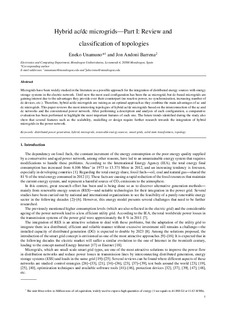Izenburua
Hybrid ac/dc microgrids. Part I : Review and classification of topologiesBertsioa
Postprinta
Eskubideak
© 2015 Elsevier LtdSarbidea
Sarbide irekiaArgitaratzailearen bertsioa
https://doi.org/10.1016/j.rser.2015.07.194Non argitaratua
Renewable and Sustainable Energy Reviews Vol. 52. Pp. 1251–1259. December, 2015Lehenengo orria
1251Azken orria
1259Argitaratzailea
ElsevierGako-hitzak
Distributed power generationHybrid
microgrids
Renewable energy sources
Laburpena
Microgrids have been widely studied in the literature as a possible approach for the integration of distributed energy sources with energy storage systems in the electric network. Until now the most u ... [+]
Microgrids have been widely studied in the literature as a possible approach for the integration of distributed energy sources with energy storage systems in the electric network. Until now the most used configuration has been the ac microgrid, but dc-based microgrids are gaining interest due to the advantages they provide over their counterpart (no reactive power, no synchronization, increasing number of dc devices, etc.). Therefore, hybrid ac/dc microgrids are raising as an optimal approach as they combine the main advantages of ac and dc microgrids. This paper reviews the most interesting topologies of hybrid ac/dc microgrids based on the interconnection of the ac and dc networks and the conventional power network. After performing a description and analysis of each configuration, a comparative evaluation has been performed to highlight the most important features of each one. The future trends identified during the study also show that several features such as the scalability, modeling or design require further research towards the integration of hybrid microgrids in the power network. [-]






















